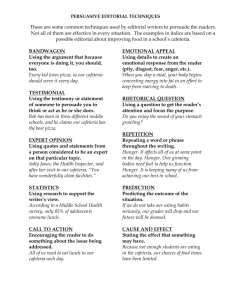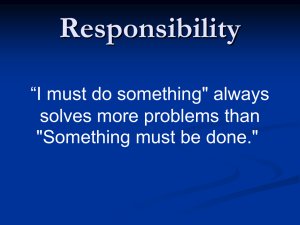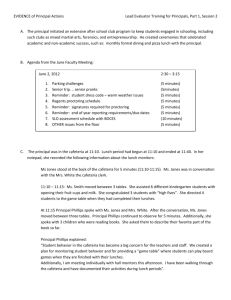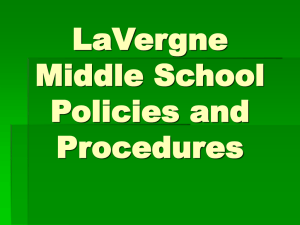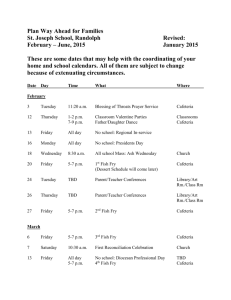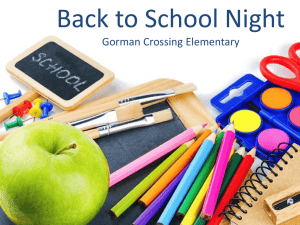Sample Elementary Cafeteria Procedures Lesson Plan
advertisement
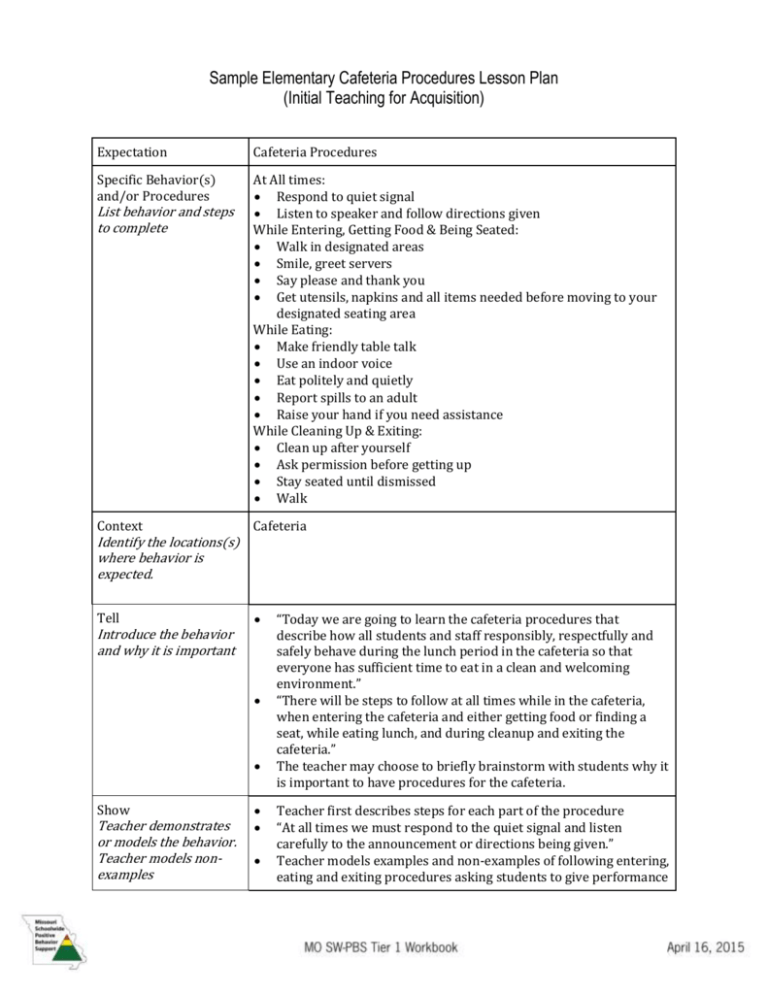
Sample Elementary Cafeteria Procedures Lesson Plan (Initial Teaching for Acquisition) Expectation Cafeteria Procedures Specific Behavior(s) and/or Procedures At All times: Respond to quiet signal Listen to speaker and follow directions given While Entering, Getting Food & Being Seated: Walk in designated areas Smile, greet servers Say please and thank you Get utensils, napkins and all items needed before moving to your designated seating area While Eating: Make friendly table talk Use an indoor voice Eat politely and quietly Report spills to an adult Raise your hand if you need assistance While Cleaning Up & Exiting: Clean up after yourself Ask permission before getting up Stay seated until dismissed Walk List behavior and steps to complete Context Cafeteria Identify the locations(s) where behavior is expected. Tell Introduce the behavior and why it is important Show Teacher demonstrates or models the behavior. Teacher models nonexamples “Today we are going to learn the cafeteria procedures that describe how all students and staff responsibly, respectfully and safely behave during the lunch period in the cafeteria so that everyone has sufficient time to eat in a clean and welcoming environment.” “There will be steps to follow at all times while in the cafeteria, when entering the cafeteria and either getting food or finding a seat, while eating lunch, and during cleanup and exiting the cafeteria.” The teacher may choose to briefly brainstorm with students why it is important to have procedures for the cafeteria. Teacher first describes steps for each part of the procedure “At all times we must respond to the quiet signal and listen carefully to the announcement or directions being given.” Teacher models examples and non-examples of following entering, eating and exiting procedures asking students to give performance feedback with thumbs up for appropriate and thumbs down for inappropriate. Practice Give students opportunities to role play the behavior across all relevant settings Pre-correct/ Remind Anticipate and give students a reminder Monitor Supervise Move, scan and interact with students Feedback Observe student performance & give positive, specific feedback Reteach Practice throughout the day Have students first role-play while in the classroom immediately after the Show portion of the lesson. Teacher sets a time to practice cafeteria procedure in the cafeteria before lunchtime begins on the first day. If students are the youngest in the building (e.g., kindergarten or first grade) have older students available to first model and then assist in practice. Before leaving the classroom teacher prompts students by saying, “Who can remind us of how we should enter the cafeteria and get our lunch?” While students are waiting in the lunch line the teacher may say, “Remember to say please and thank you and to greet our cafeteria workers with a smile” or “Remember to get everything you need and walk to our designated table.” When students are seated, “Remember to use your inside voice, use polite table manners, and clean up after yourself. Wait for permission to throw away trash and line up to leave the cafeteria.” If students are the youngest in the building (e.g., kindergarten or first grade) have older students assist in cafeteria during the first week of school. The teacher will assist all his/her students through the line and to the designated seating area before exiting the cafeteria. Teachers will provide prompts, specific positive feedback and corrections as needed to any and all students during this time. “Thank you for remembering to greet the cafeteria workers with a smile and for saying thank you, that is being respectful of others.” “Thank you for raising your hand and letting me know there was a spill under the table, that shows respect for our school building.” Teachers can ask for feedback from cafeteria supervisors or janitors regarding student behaviors and cleanliness of cafeteria when their class exits. This serves as information about what the students might need to re-practice, as well as opportunities for the teacher to recognize students for following expected procedures and how this contributes to a safe and welcoming cafeteria environment. Teachers should plan for whole class re-teaching sessions whenever a new student joins the class, whenever feedback from other adults indicates there is a need, or after vacations or extended breaks in the school year.
